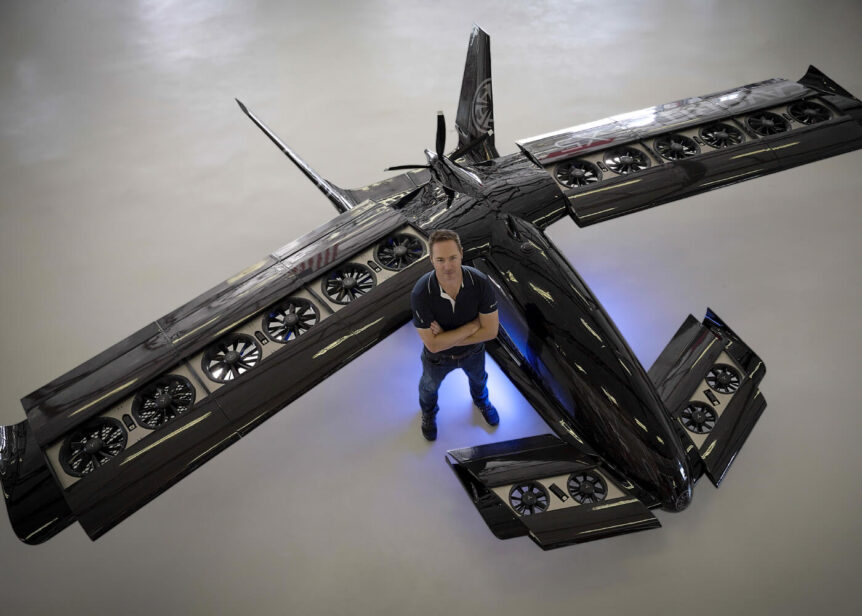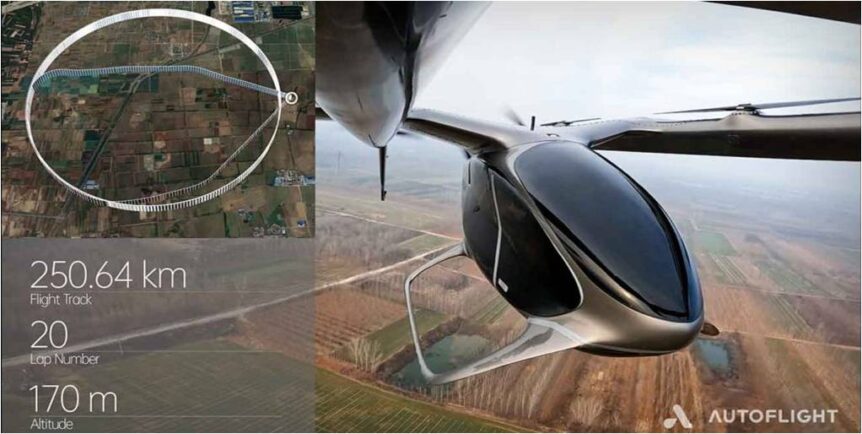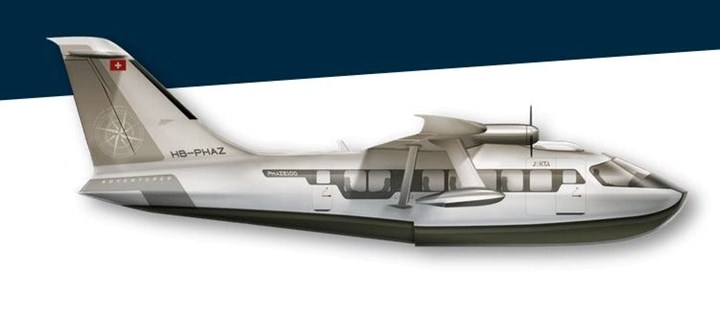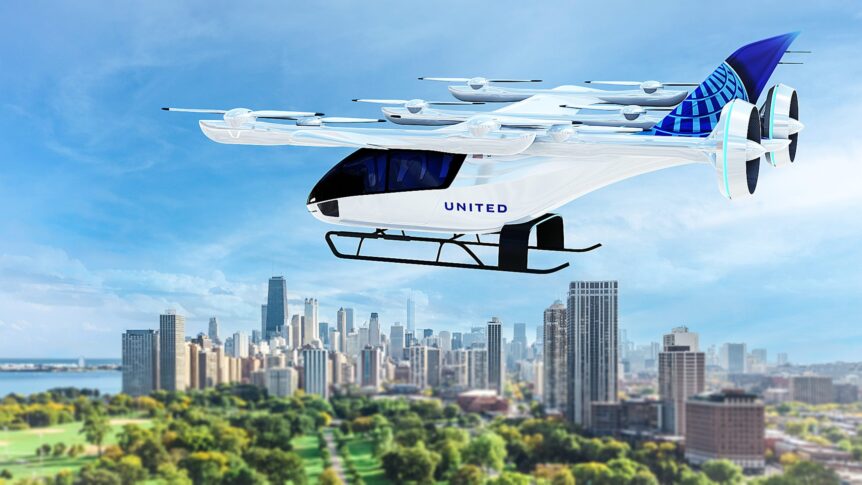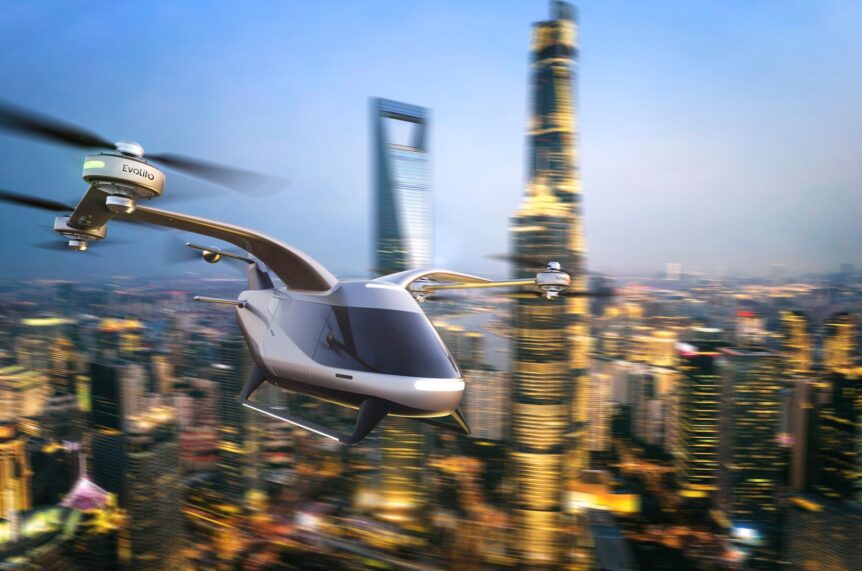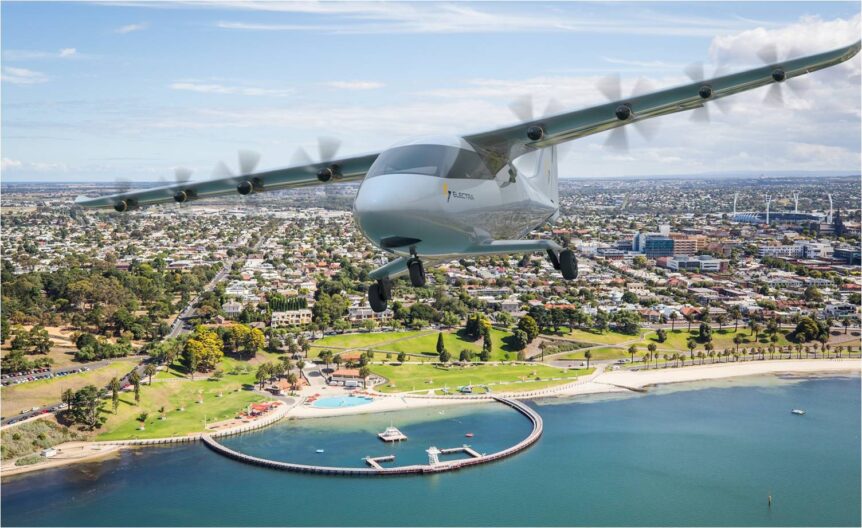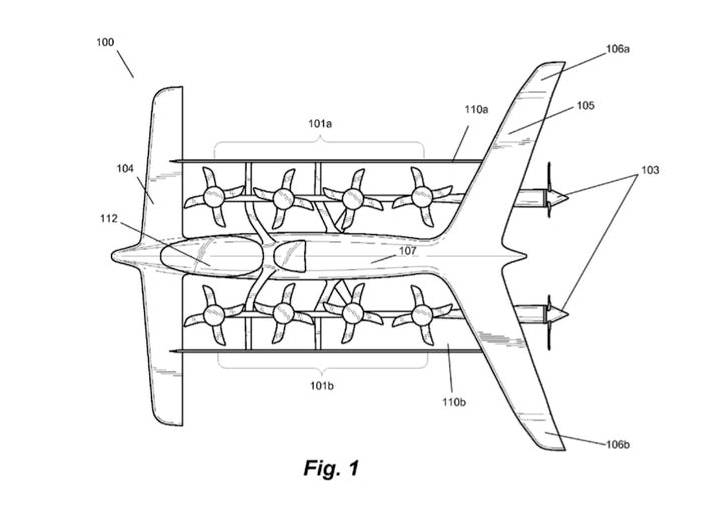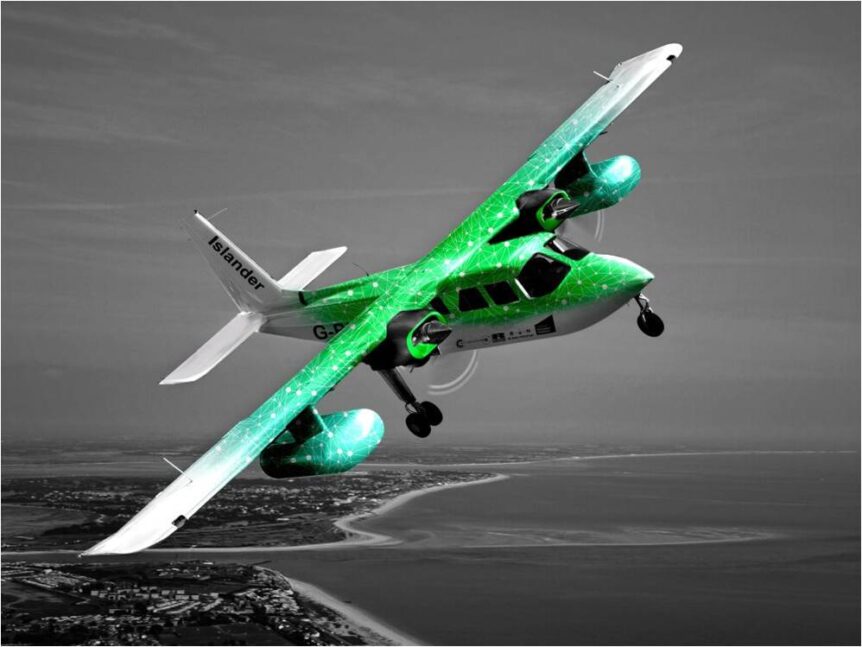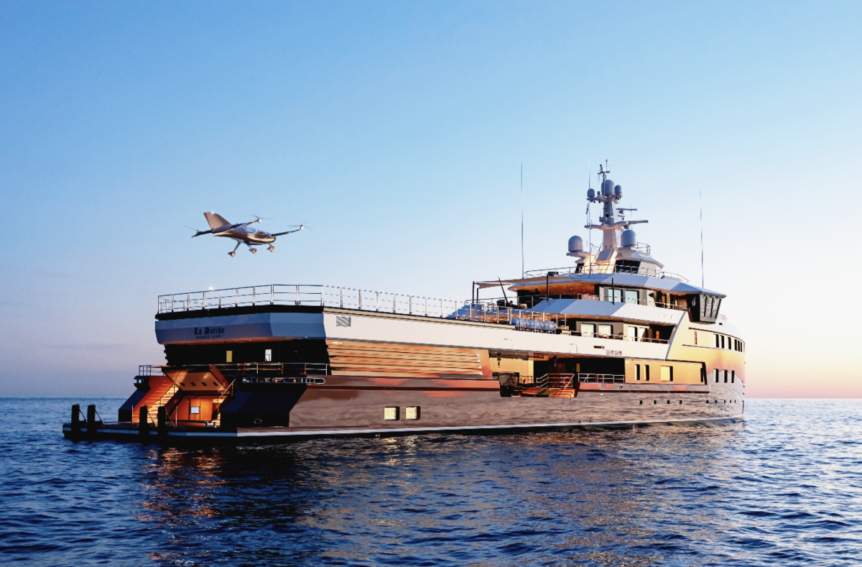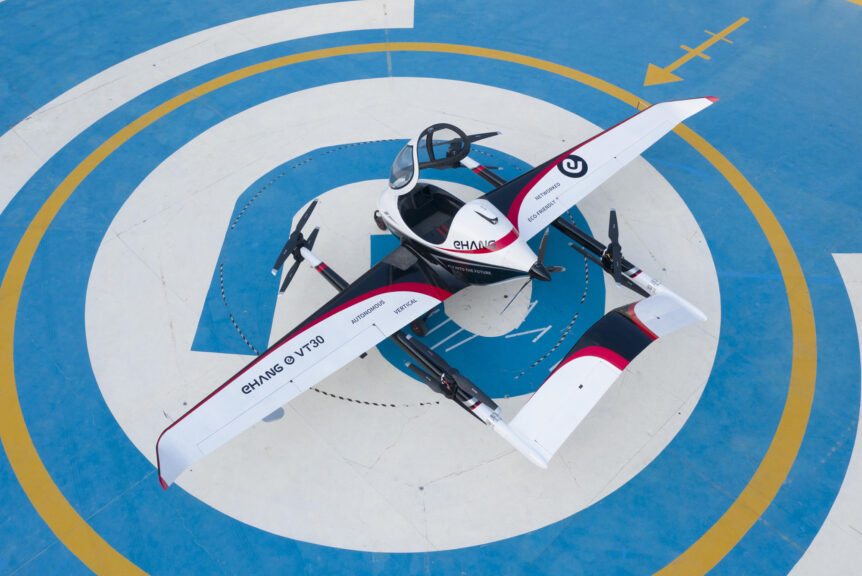The Cavorite X5, now in developmental test flights, that came from the inspiration of H. G. Wells. Cavorite was the mysterious metal in Wells’ First Men in the Moon, discovered by Dr. Cavor. He explains it to his friends, who are attempting to reach the earthly satellite: “Well, so soon as it reached a temperature of 60 Fahr[enheit], and the process of its manufacture was complete, the air above it, the portions of roof and ceiling and floor above it ceased to have weight. I suppose you know – everybody knows nowadays – that, as a usual thing, the air has weight, that it presses on everything at the surface of the earth, presses in all directions, with a pressure of fourteen and a half pounds to the square inch? ” “I know that,” said I. “Go on.” “I know that too,” he remarked. “Only this shows you how useless knowledge is unless you apply it. You see, over our …
Nudging, Then Doubling an Electric Distance Record
Suddenly, we’re seeing new electric aircraft nudging, then doubling an electric distance record. First, Autoflight in China and then Beta in America achieve higher ranges than that previously achieved by Joby. Jules Verne Saw It Coming In two late 19th-century novels, Robur the Conqueror and Master of the World, Jules Verne chronicled the fictional adventurers of a mad inventor who thought he could dissuade world leaders from practicing war by bombing them from his Albatross flying warship. A great deal like Captain Nemo of Nautilus fame, Robur uses violence to stop violence. Both protagonists fail in their efforts. The Albatross, mistaken as its objectives were, is perhaps an inspiration for today’s eVTOLs, propellers spinning for lift and for forward motion. Verne even prophesied fueling the Albatross with water, perhaps an early vision of today’s water-splitting to produce green hydrogen. Autoflight With far fewer rotors and propellers, Autoflight achieved a successful transition flight from vertical liftoff to forward flight. This delicate …
Jekta’s Amphibious Commuter Liner
Jekta’s amphibious commuter liner made its debut at the Abu Dhabi Air Expo 2022. The 10-motor amphibious, 19-passsenger craft could become a familiar sight at coastal landings around the world based on initial interest. Deena Kamel, reporting for The National News, revealed PHA-ZE 100, short for Passenger Hydro Aircraft Zero Emissions, is now in its design stage, “with a prototype scheduled for 2026 before entry into market by 2028,” according to Jekta CEO George Alafinov. Intended to transport people in mega-cities and coastal areas “sustainably and affordably,” according to the article, the 19-passenger is a response to a “world population with an appetite to travel safely, cheaply and ecologically.” Mr. Alafinov makes the case for amphibious craft. “The solution is in front of us: Instead of building airports with devastating irreversible environmental impact, we can use nature’s gift of oceans, lakes and rivers to create an affordable transport system using amphibian aviation.” Further making his case, he added, “Today’s seaplane …
Delta and Joby: United and Archer and Eve
Delta and United Airlines are teaming with eVTOL makers Joby, Archer, and Eve – elevating ways to get to and from their airports. The newly-formed alliances will make airline travel a little less tedious and eliminate the often long and sometimes frustrating drives between flights. Delta and Joby Delta Air Lines will invest $60 million in a partnership with Joby Aviation in return for a two-percent stake in Joby and a seat on its board. Joby can receive another $140 million if it meets “certain milestones.” The selling points of convenience and time saving could certainly entice prospective customers. Initially set up as premium services in New York City and Los Angeles, passengers would still rely on automobiles or shuttles to get them from home or office to a heliport (eventually to be a “vertiport”). There, the passenger boards a Joby five-seat tiltrotor aircraft and flies to the airport in around 10 minutes – a huge time saving over ground …
Evolito and ElectroFlight
A Profusion of Names Evolito is the new name for YASA motors that fly. YASA (Yokeless and Segmented Armature) motors are a product of Oxford University research, and have become a wholly-owned subsidiary of Mercedes-Benz. Mercedes is now creating and marketing a line of electric vehicles using the YASA motors. But what of aeronautical applications? With that in mind, Mercedes spun out Evolito, taking YASA skyward with “high-power density, light-weight electric motors and controllers for aerospace applications.” Evolito’s Managing Director, Gareth Morris, explains, “We’re building the future of electric flight with motors that have the highest power and torque densities in class with the ability to manufacture at scale, whilst achieving efficiencies of over 98%.” Although their web site claims the YASA configuration is a “revolutionary new approach” to motor design, it’s a careful revamping of the axial flux technology invented almost 40 years ago by Cedric Lynch, a self-taught English inventor. Evolito’s axial-flux motors contain significant improvements. Two motors …
Following the Money to Green Flight
The path to green flight is paved with money. In our transactional world, good ideas are sometimes rewarded with filthy lucre, even if those ideas are intended to clean up a besmirched world. Several examples of clean aviation attracting solid investments follow, along with some stumbling on unexpected obstacles. Jetson ONE For a flying machine lighter than most of its prospective pilots, the Jetson ONE has attracted a host of followers, including the host of a late-night chat show. Besides receiving 3,000 purchase requests in two months the firm has sold its initial production runs for 2022 and 2023. At $92,000 a unit, 100 craft in the first year would net $9.2 million, enough to finance the simple assembly and fabrication of the machines. A $22,000 deposit would discourage idle gawkers, although Internet views exceed 14 million. Keeping it simple allows reasonable progress to the next level. Opener Blackfly Opener claims over 36,000 flight hours in 5,000 operations for …
Kittyhawk to Close Doors, Open Another
While Eviation’s Alice is drawing adulation for its initial test flight, Kittyhawk, a one-time front-runner and pioneer is quietly closing down. A vision of Larry Page, Sebastian Thrun, and Ilan Kroo, Kittyhawk brought us several approaches to personal green flight, with a heavy emphasis on intuitive control and automated flight. One of its many approaches lives on, though, through sister company Wisk. Blooper Reel Kittyhawk’s earlier efforts look somewhat like an aeronautical blooper reel, one of those montages of early flying machines that evoke laughs when shown as preludes to more serious stuff in movie theaters. Kittyhawk, though, avoided crashes and humiliation. The firm explains its history: “Kittyhawk was founded in 2010 by autonomous car pioneer Sebastian Thrun with the backing of Google co-founder Larry Page to explore the frontier of then-new eVTOL aviation.” From Zee to Kittyhawk Originally founded as Zee Aviation, Kittyhawk was secretive, with only glimpses of its potential aerial vehicles surfacing as “spy shots.” The ZP-1 …
Cranfield: Hub of Electric Aviation
Cranfield, England and its local university are hubs for electric aircraft development. Dr. Guy Gratton is test flying The Light Aircraft Company’s eKub on 48-Volt battery power, ZeroAvia is crafting a Dornier 228 to run on hydrogen, and now Cranfied Aerospace Solutions (CAeS) is readying a Britten-Norman Islander for H2-powered flight in 2023. The Islander Living up to its name, Britten-Norman’s Islander seems to be busy worldwide island hopping. The twin-engine plane ever makes the world’s shortest scheduled flights, including this between Juist to Norden across the Wadden See. The 74-second flight is less than the time spent taxiing at the beginning and end of the hop. Designed and developed in the 1960s, 750 Islanders of the 1,280 built are in service with many small airlines and over 30 militaries. Now, other enterprises are banding together with Britten-Norman and Cranfield Aerospace Solutions (CAeS) to bring hydrogen flight to the Isles of Scilly, a popular English vacation destination. Three companies signed …
Flying Machines in Your Two Car Garage
A flying machine in your two-car garage was the promise heralded by Popular Science and Popular Mechanics magazines during the 1950s and 1960. It was the era of Bob Cummings piloting his Aerocar on his popular TV show, and KISN radio watching over traffic with one in Portland, Oregon. Expectations were high and often disappointed. High costs of establishing a network of two-ton, four-passenger eVTOL (electric Vertical Take Off and Landing) machines dissuaded even Uber from pursuing that goal. Consider that skyports, vertiports, or whatever they ended up as are enormously expensive, and a network with charging stations and passenger accommodations would be a large investment. Beyond that, each sky taxi would cost well into the high six figures, something that would require corporate ownership rather than the owner/driver model on which Uber’s land-based operations depend. At least four eVTOLs are now on the market or headed there. None cost more than a claimed $150,000 base price, a plausible outlay …
Lift + Cruise Transitions for eVTOLs
A New Mission Some formerly rotor-only eVTOLs are transitioning to a new configuration – one with wings for greater range and speed. Vertical takeoffs and landings are OK for short-range Urban Air Mobility (UAM), but not necessarily good for longer range flight. Hovering flight requires thrust equal to the weight of the vehicle, and climbing requires additional thrust. Switching to wing-borne flight reduces the power necessary and increases flight duration. Some trends in housing and commutes indicate longer, regional flights may be necessary to fetch workers from ever more far-flung homes. Purely rotor-borne flight will still be viable for short trips with batteries, but wings add speed and endurance. VoloConnect Volocopter, having started with a simple multi-rotor prototype 10 years ago, now offers VoloCity, an 18-rotor eVTOL (electric Vertical Take Off and Landing) craft soon to start service in Singapore, Since the island nation is only 283 square miles, about 3.5 times the size of Washington, D. C, that makes …

